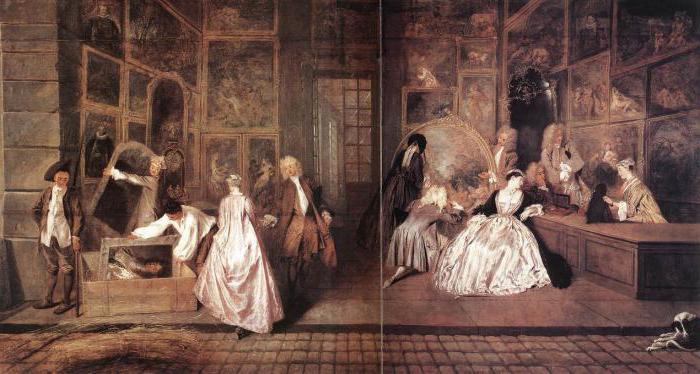Today we will introduce the French artist Jean-Antoine Watteau (1684-1721). He lived only 36 years, having died from tuberculosis, but left a poetic legacy: “gallant scenes”, touched by irony and subtle lyricism, imbued with grace and harmony.
Brief information about the painter’s legacy
Jean-Antoine Watteau was born in a province in a poor family. He reached Paris on foot and began to collaborate in the theater, constantly drawing from life, and did not receive professional education. The formation of Watteau as an artist dates back to 26 years, and the heyday of creativity - to the 32nd. It must be remembered that after 4 years his illness will end his life. Contemporaries did not just appreciate Watto's paintings. Antoine - Jean delighted them. Such widespread success should be attributed to the fact that the painter looked differently at the "gallant scenes" that were known by this time. Watteau Antoine - Jean painted not just as a celebration of art and love. He invested in them a depth that was later inaccessible to his followers. Time will pass, and his work will be forgotten for a long time. Poets of the XIX century will open the paintings of Watteau. Antoine - Jean will be especially appreciated by Baudelaire, Verlaine. A poem by T. Gauthier will devote to him. The Goncourt brothers will consider that Watteau Antoine painted the paintings, creating samples of poetry and dreams. Inspired by Watto's painting, composer C. Debussy created a piano piece based on the masterpiece “Pilgrimage to the Island of Kiferu”.
Watteau's first masterpiece
The art of being pleasant in society was captured by a painter in the work mentioned above. Refinement and refinement are distinguished by the “Pilgrimage ...”, which was created in 1717.

The mystery for researchers is whether it is returning from the island or sailing to it. At the foot of the statue of Venus, a young woman hears compliments from her gentleman, who is kneeling before her. In the next pair, an impatient companion hands over to a lady who sits motionless on the ground. The third pair is standing. The lady turns back and looks with regret at the place where she was happy. At the feet of her companion is a dog who personifies fidelity. The rest of the pilgrims, with jokes and noise, descend to the gondola, which sways on the water like a golden dream, entwined with garlands of flowers and scarlet silk. The color is composed of warm pink and golden tones, which are complemented by green and blue. In the same poetic manner of “gallant scenes”, Jean-Antoine Watteau performed paintings with the names: “Fix” and “Capricious” (GE), “Lesson in love”, “View between the trees”, “Society in the park”, “Love song "Venetian holiday."
National Gallery in London
It houses the famous work of Watteau, written in 1717, - Le gamma de l'amour.
The diagonal composition draws attention to large figures of the foreground: a girl in a magnificent dress made of iridescent taffeta, the shades of which, barely touching the canvas with a brush, were painted by the painter. Highly raised hair opens the elegant neck of the model. The notes in her hands are just an excuse, so that her companion could freely look into the low-cut corset, exciting the girl and herself with a gentle serenade and no less ardent glances. Above them is placed a strict bust of the philosopher, which does not at all interfere with a couple carried away by each other. As well as their other supporting characters do not care. The center is designed in pink and gold tones, which stand out against the background of lush park greenery.
Hermitage, psychological study
In the genre gallant scene “The Capricious Girl” nothing distracts attention from two characters: a young girl and her experienced companion in love. The model is hesitant: take offense at the overly explicit speeches of the gentleman and leave or stay to listen to his compliments.
She pouted her lips and is already picking up a fluffy skirt. Her companion imposingly settled down behind her and does not at all seek to persuade her to stay. Experienced, he knows that the next meeting is inevitable and will lead to the surrender of this young creature. Jean-Antoine Watteau fills paintings not only with poetry, but also with a subtle penetration into the spiritual world of his heroes.
Berlin, "Sign of the Gersen's bench"
In 1720, a completely sick artist wanted to write a sign for the antique shop of his friend Gersen, but it was always just a picture that was reverently considered. This is the last masterpiece that Watteau wrote with cooling fingers.

The canvas, composed of two parts, is completely different from all previous works. This is work with the interior of the store, not with nature. The front wall is “removed” by the artist, and the viewer sees what is happening in the boutique, as well as the cobblestone Parisian bridge. Three walls are hung from top to bottom with paintings of different sizes. In the foreground, the seller carefully puts a portrait of Louis XIV, who recently died, in a wooden box. A portrait of his relative, King of Spain Philip IV, hangs high in the left corner. The second part depicts buyers who are viewing through the lorgnette the details of a huge painting made in the form of an oval. The remaining paintings on the walls represent still lifes, landscapes, mythological scenes. Perhaps the artist’s intention was to present the whole history of painting and his changes as an artist who, for the last time, looks dreamily and sadly back at his years.
We examined a small part of the paintings that were written by Jean-Antoine Watteau. Famous paintings of the painter are in all major museums in the world.